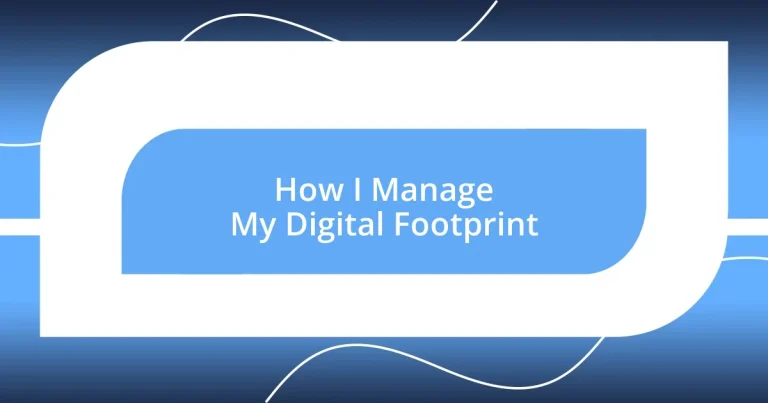Key takeaways:
- Every online interaction contributes to a digital footprint, which shapes personal branding and can result in targeted advertisements.
- Maintaining control over privacy settings and regularly reviewing personal data across platforms is crucial for managing one’s digital presence.
- Building a positive online reputation involves intentional sharing, meaningful engagement, and authentic storytelling, which reinforce personal values and skills.
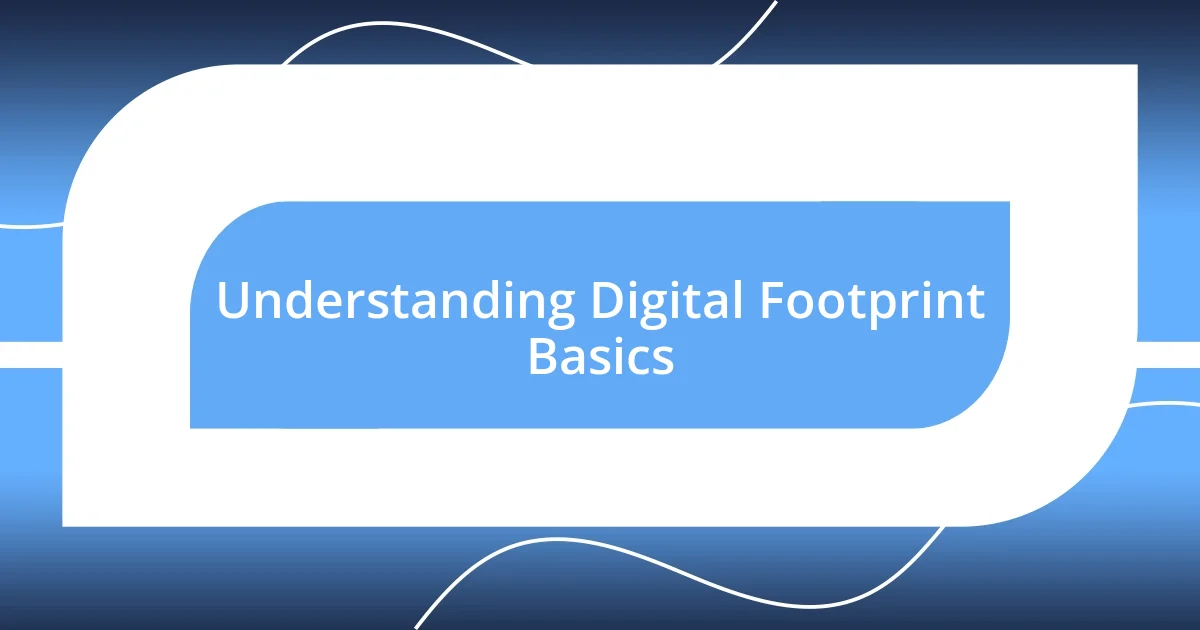
Understanding Digital Footprint Basics
Every time I browse the internet, post on social media, or even send an email, I leave behind a digital footprint. It’s fascinating to think about how every click and interaction creates a trail that companies can track. Have you ever wondered how much of your online activity gets recorded?
When I first learned about digital footprints, I felt a mix of curiosity and concern. I realized how much personal information can be inferred from my online presence—things I hadn’t even considered, like the ads tailored specifically to my interests. It’s like a puzzle, where each piece is a part of my online life, and I started asking myself: how complete is that puzzle, really?
Reflecting on my online habits, I noticed that even the smallest online actions accumulate over time. The posts I thought were harmless or the comments made in passing can shape how I’m perceived both personally and professionally. This realization made me more mindful of my digital interactions and encourages me to think twice before hitting ‘send.’
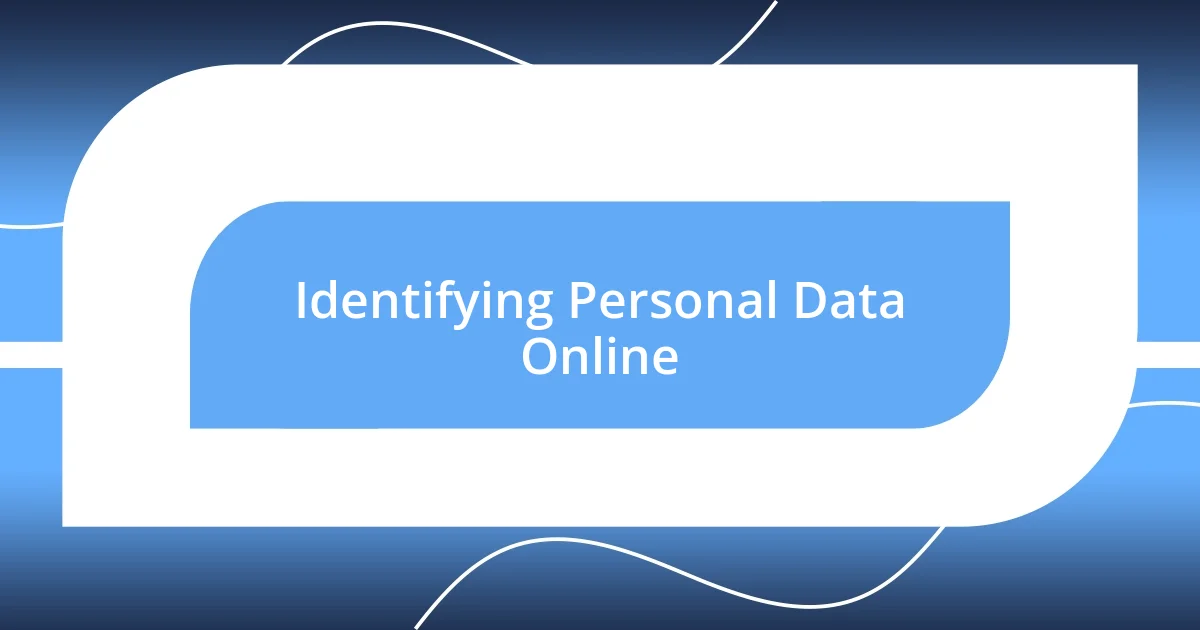
Identifying Personal Data Online
Identifying personal data online can feel overwhelming, especially when you start to realize just how many platforms collect information about you. For example, when I signed up for a new app, I was surprised to see how many permissions it requested—access to my contacts, location, and even my calendar. It made me wonder, am I sharing too much without even realizing it?
In my experience, social media is a goldmine of personal data. I often think about the times I’ve shared seemingly innocuous updates, only to later find that those posts contributed to targeted ads that seemed too personal. Using privacy settings and being conscious about what I share has become crucial for me in managing what’s out there.
It’s not just social networks, though; websites I visit also track my behavior. Last week, while online shopping, I was shocked to discover that my browsing history had been stored, influencing the deals I saw. Realizing that my digital movements can be monitored like this reminded me to be more intentional about the information I add to my digital profile.
| Type of Personal Data | Examples |
|---|---|
| Social Media Activity | Status updates, photos, comments |
| Shopping Habits | Browsing history, transaction records |
| Location Data | Check-ins, GPS data from apps |
| Contact Information | Email addresses, phone numbers |
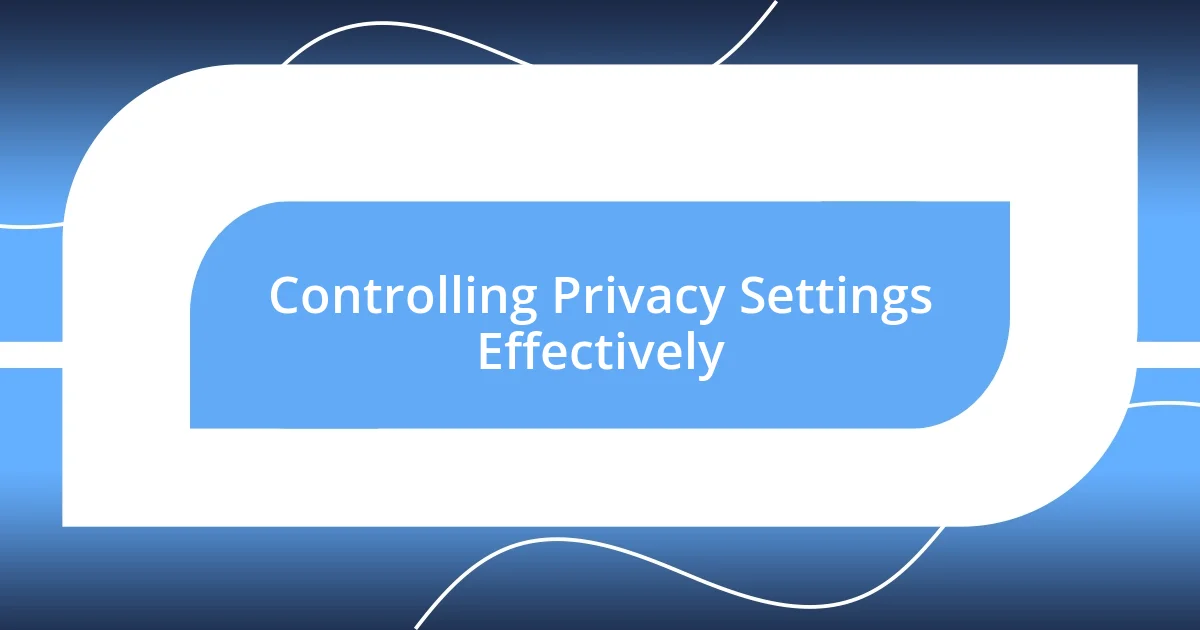
Controlling Privacy Settings Effectively
I’ve learned that effectively controlling my privacy settings is essential in maintaining my digital footprint. It’s surprising how many apps and platforms have options buried deep in their settings. Just the other day, I stumbled upon a Facebook privacy update that allowed me to limit who could see my posts and even my friend list. I felt a wave of relief wash over me knowing that, with a few clicks, I could regain a bit of control over my online presence.
To really take charge of my privacy, I focus on these key areas:
- Social Media Accounts: Regularly review and adjust privacy settings to limit visibility of posts.
- Location Services: Disable GPS tracking for apps that don’t need it, especially social media and shopping apps.
- Application Permissions: Before downloading an app, I check the permissions it requests; it’s shocking how many want access to my contacts or camera without a real need.
- Account Activity Logs: I frequently check the activity logs on my accounts; it allows me to see who’s interacting with my content and adjust settings if something feels off.
- Profile Information: Only share necessary information in profiles. I always think, “Do I really need to include my birthdate or location?”
This ongoing process of fine-tuning my settings not only enhances my online security but also brings me peace of mind. It’s like tidying my online space—I feel lighter and less exposed to the digital world.
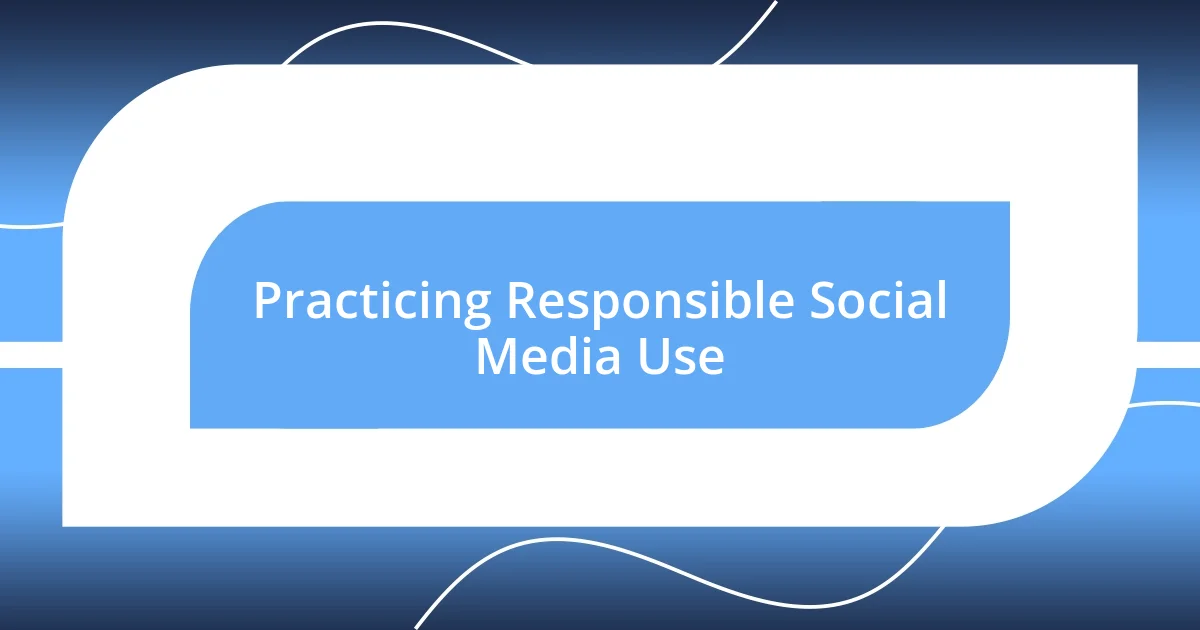
Practicing Responsible Social Media Use
Social media can be a double-edged sword. I remember the first time I shared a fun photo from a vacation. Friends loved it, but soon after, I was bombarded with travel ad suggestions. It made me think—was that innocent post now amplifying my digital footprint? I’ve since become more selective about what I share and who can see it. Each post feels like I’m leaving a little breadcrumb behind, and I’ve started to ask myself, “Is this really worth it?”
One tactic I’ve found effective is curating my friend list. I’ve pruned my connections more than once, removing people whose interactions felt superficial. It’s liberating to realize that my social media is for my enjoyment and engagement, not a popularity contest. By focusing on quality over quantity, my online experience has transformed; it feels more authentic and safe. Have you thought about who truly enriches your online life?
Additionally, I consciously engage instead of just scroll. Instead of mindlessly liking posts, I take the time to comment or share my thoughts on something that resonates with me. This conscious interaction not only helps me build meaningful connections but also makes me more aware of the content I consume. Engaging more genuinely keeps my digital self aligned with my values, rather than a mere reflection of trends. Have you noticed how much more fulfilling it is to connect over shared interests rather than fleeting moments?
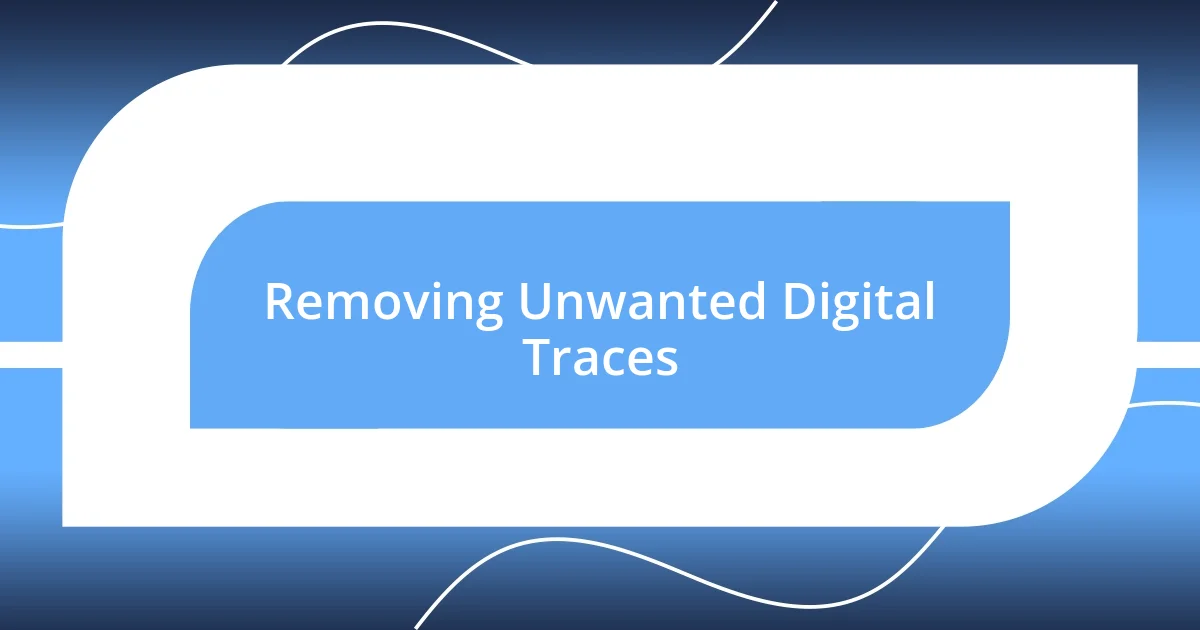
Removing Unwanted Digital Traces
One of the first steps I took in removing unwanted digital traces was to conduct a thorough audit of my online accounts. I can vividly recall spending an afternoon combing through my old accounts, deleting ones I had completely forgotten about. Have you ever opened an old email account only to find a list of subscription emails that made you cringe? It made me realize how many digital footprints we leave behind without even noticing.
Next, I began the process of requesting data deletion from various platforms. I remember drafting messages to customer support asking them to remove my information. There’s something empowering about taking that step. It’s like reclaiming a part of myself; I think, “I don’t need you to hold onto my data, thank you very much!” Moreover, some platforms even make this easier with options available in their privacy settings, which can save time and effort.
Finally, I’ve sought to manage my presence by Googling myself regularly. The first time I did this, I was shocked to see old photos and comments pop up that I had long forgotten. It led to a realization: I never want to be surprised by what others can find about me online. It’s a constant reminder that my digital actions have the potential to linger, nudging me to think twice before sharing. Isn’t it fascinating how something shared in a moment can represent us for years?
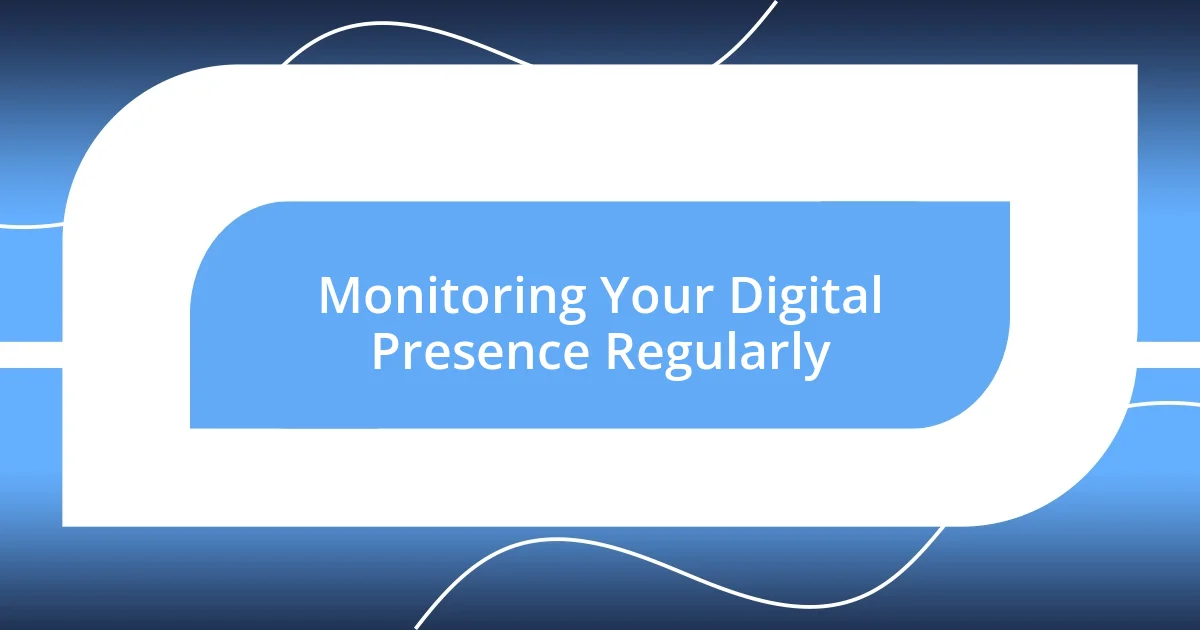
Monitoring Your Digital Presence Regularly
Monitoring my digital presence has become a regular ritual, much like checking my emails each morning. I set aside time every month specifically to review my online profiles and activity. It’s fascinating how a simple search of my name can reveal what others see. I once stumbled upon a forum where someone linked to an old blog post I’d written in college, and it made me cringe a bit. How many people might have read it without my knowledge?
Now, I also keep an eye on what I post across different platforms. I recall a time when I shared a controversial opinion on a trending topic without considering the potential backlash. The flood of reactions that followed taught me a valuable lesson about the permanence of digital interactions. Having that realization has led me to think critically before hitting “send.” Have you ever paused to consider how a simple comment might shape someone’s perception of you?
Additionally, I use tools and alerts to stay updated on my online mentions. I remember setting up Google Alerts for my name, and the first time I received a notification was both exhilarating and unnerving. It reminded me that my digital footprint is continually evolving. Being proactive about it helps me maintain control over my narrative, ensuring that the information out there aligns with who I am today. Are you aware of what’s being said about you in the vast digital landscape?
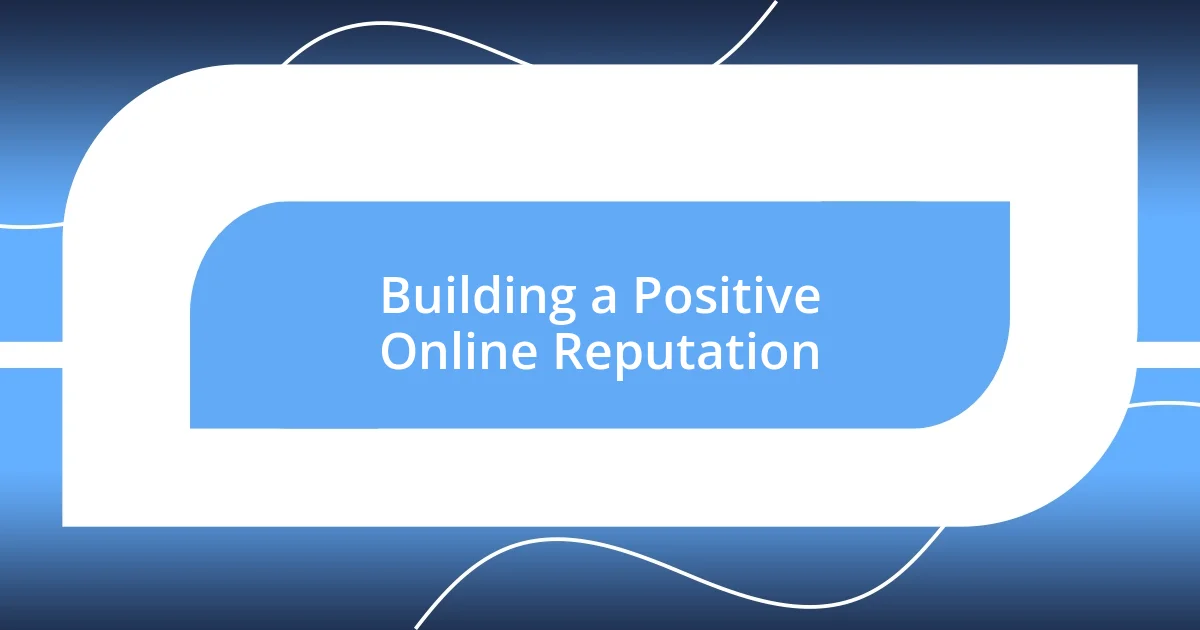
Building a Positive Online Reputation
Building a positive online reputation often starts with being intentional about what I share. I remember a time when I stumbled upon a heartfelt post from a colleague celebrating success, and it struck me how effectively it reflected their professionalism. It made me think—what kind of image am I projecting online? I realized that every photo, comment, and article I share can contribute to my personal brand. Finding ways to highlight my skills and values has transformed the way I engage digitally.
Engagement plays a significant role in shaping perceptions. One day, I decided to connect with others by commenting thoughtfully on industry-related discussions rather than simply reacting. This approach fostered relationships and built trust, showcasing the kind of person I want to be seen as—approachable and knowledgeable. Have you ever considered how meaningful interactions can elevate your reputation? Reflecting on how I engage has taught me that online relationships can be just as impactful as in-person ones.
Lastly, I prioritize positive storytelling. I often share anecdotes about overcoming challenges or celebrating small victories. A few months ago, I posted about my journey in learning a new skill, which not only resonated with others but also sparked conversations. This experience opened my eyes to the power of authenticity; by sharing genuine experiences, I’m not just another face in the digital crowd. I encourage you to think about the stories you share—could they leave a lasting, positive impression on those who interact with you online?












